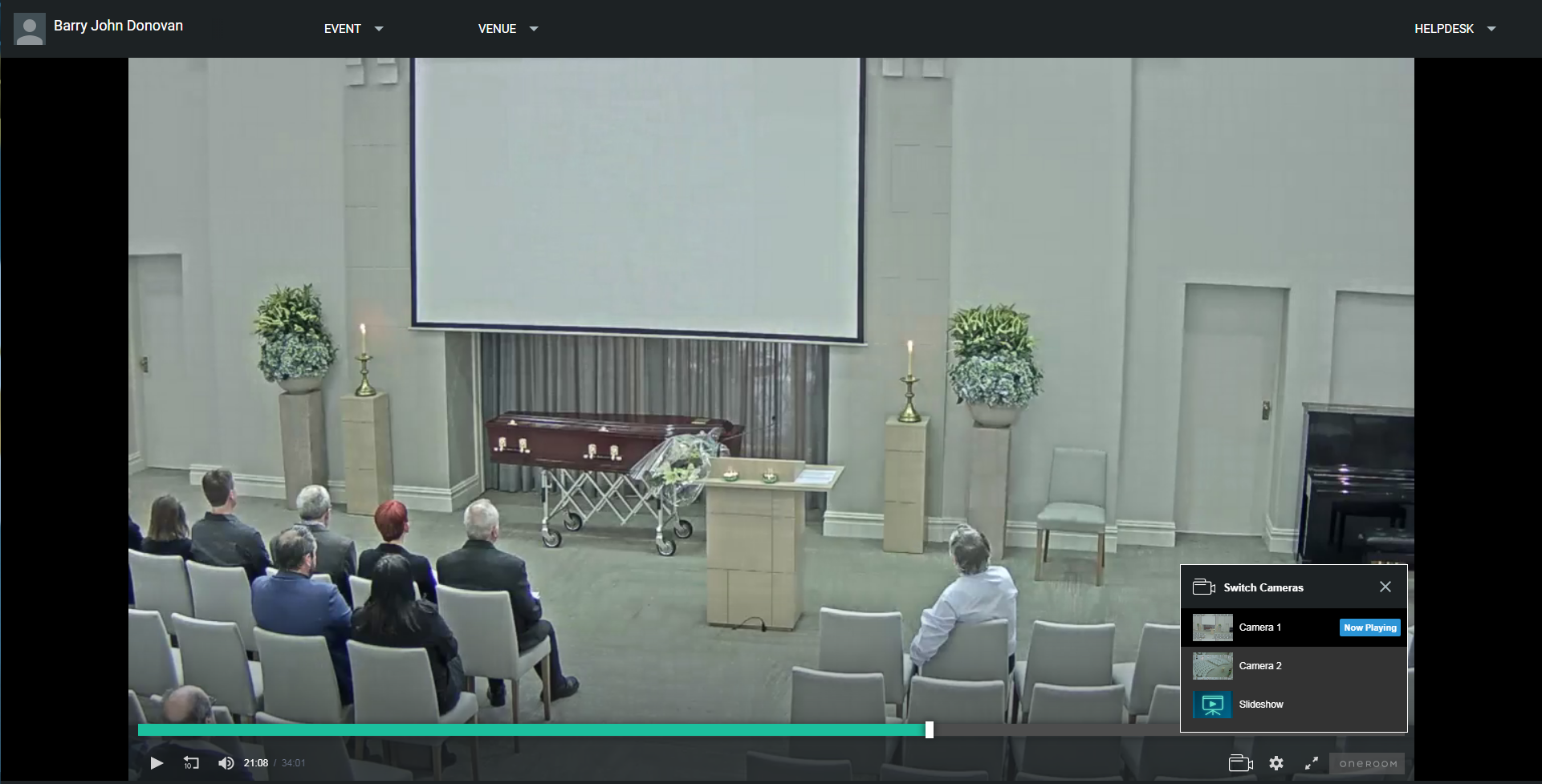
Seven years ago, David Lutterman was running a business called OneRoom that live streamed videos for corporate meetings and shareholder events when someone told him to check out the possibility of live streaming funeral services.
Well, he did. And suddenly Lutterman found himself in the death care industry. “Now all we do is funerals,” he says.
Digital Dying recently connected with Lutterman half a world away in New Zealand, where he says two out of three funeral directors already use his service. We wanted to see just what was up with OneRoom’s product, learn more about Lutterman’s plan to expand the business in the United States, and talk about whether live streaming funerals represents the death of funerals as we know it, or a bright new beginning.

David Lutterman of OneRoom
Tell me more about how you were led to OneRoom, and just how the company is doing in New Zealand?
I was led here by the market. We started looking around the world and saw this was a white space. So we decided to stop doing shareholder meetings and build this product and try to get it as good as possible and get a good piece of the global market. The uptake was quick and it has gone incredibly well. In New Zealand, a significant portion of the total death rate is live streamed with OneRoom. There are probably about 35,000 deaths a year in New Zealand, and about 66 percent of funeral directors in New Zealand use our product. So, this has become a standard service. We are in a relatively small country, you can compare it to the state of Louisiana. I think the National Funeral Directors Association president said about only 20 percent of the market in the US offers live streaming. It’s like I am coming from the future and telling you what is going to happen here. I know this service is going to take off.
Tell me about the hardware?
The cameras resemble security cameras but are high-definition and connected to the internet. They have a memory card inside, so if the internet goes down we can access the camera and restore the full recording. We can install multiple cameras at a location, and no one has to operate those cameras, it is a completely closed system. Funeral directors do not have to push buttons. Once you get in and schedule the times for those cameras they start recording. Then you send an invitation out to the family, and the family decided how many people they want to see it. They can make the video as public or private as they want it to be. The benefit for the funeral director is they don’t have to install any AV equipment, they just hit the button and it works.
Some homes are happy to have just one camera pointed at the front of the room, sometimes we also put cameras in an overflow room, or outside so that we can capture the hearse pulling up. Everything is streaming simultaneously, so it is the end viewer who chooses which camera they want to watch. This gives them a very immersive and interactive experience.
Who tends to use your service?
When we first started doing this we thought it was really going to be about the live experience. That is, being there in the time at that moment on that day. Sometimes people want to feel connected in the same time, but on average only about one-third of the time is the funeral watched live. Two-thirds of the funerals are watched on-demand later. But the important thing is that being online makes the service much easier for people to go back and watch. We have also found that there are family who were at the service but completely missed it because they were too choked with emotion, and now these people can go back and watch later. In some cases, over 2,000 people have accessed a single service.
Where does OneRoom do the most business?
Where we see a real high uptake is immigrant communities. They are very family-oriented communities and also have many family members living far away and when someone dies there is an impulsion to be there but often you can’t. Another area we see big numbers online is the death of a younger person, because guess what—that market expects to be able to access it online.
Can a home funeral or an outdoor funeral use OneRoom?
There are two things that make OneRoom work, simplicity and reliability. A funeral service is like a show on Broadway that only runs once. You only get one chance and if you screw it up you are done. That’s why we remove the human element and everything is automated. The only thing that would prevent us from getting a service filmed is if the power goes out and moving out of the comfort of a funeral home would raise that concern. Also, as soon as you move offsite you are talking about installing a mobile connection for wifi, and you are asking a videographer to get involved. Then you have the possibility of the wind blowing. Right now, we have a lot of funeral homes signed on to do our standard upload and we’re happy with that.
Are you concerned your service might actually be helping to destroy the funerary tradition?
Funeral services are an important part of grief resolution and help the family to cope. They provide such an important role to society and that role is being undermined. I would say our product brings people closer to death. Why should you limit access to death by time or distance? Why should you say that because you can’t meet a certain time frame you are not allowed to participate in this ceremony? How is that healthy. On average 65 people will be able to attend a funeral service, but on average everyone has 200 or 300 people in their lifetime community. Like me—I grew up in the United States but when I die I will probably be buried in New Zealand. My US friends are not all going to get on a plane and come to my funeral, but with this service, they can still participate in my final story.
What is coming next for OneRoom…Will viewers ever be able to direct a live comment to the funeral service itself, or deliver a eulogy from a remote location?
The problem with live comments is that the internet introduces lag, and this becomes an issue as soon as you allow someone to come in with writing or video. So you cannot have any real-time video. You could have live video or messages being posted to the link for the service, but all that has to be moderated by the family—because someone could come on and say something rude.
What is the story of OneRoom coming to the US?
In 2012 the first OneRoom funeral was streamed, and that was in New Zealand. We have been streaming funerals in the United States since 2014. Presently, we are in New Zealand, Australia, Canada, and the US. In terms of maturity, New Zealand is leading the game. I don’t like to give specific numbers, but let’s say we have thousands and thousands of funeral service viewers using our platform. By 2020, we expect to have 200,000 viewers a year. Certain pockets of the United States are waking up to this, but it is still a big white space. Again, in the US the communities where we have seen this catch on already are immigrant communities. And the Jewish sector, because the issue of the quick turnaround on internment makes it difficult for people to get to a funeral service. We have viewers across 150 countries, and we do want to be able to stream funerals in other countries. But at the moment we just want to do a good job in the United States.
Was OneRoom the first company to start live streaming funerals?
OneRoom was not the first, that probably came in 2000. But some of that early technology was clunky and that actually turned people off. Part of the problem before was that the videos were not reliable. The key is to take people out of the equation, it has to be automatic. I don’t mean this disparagingly, but whenever humans come into contact with the technology they have the opportunity to screw it up.
What to you is the most exciting trend happening in the funeral industry today?
The Millennial generation has become a lot more involved in the decision process. Some people don’t like that and think tradition is good and we should stick with what we have done, but then you are going to lose this generation. The millennials want a more personalized experience. They don’t want to be told to go sit there, the minister is going to come in and read the bible, and you are going to walk out and feel resolved. Remember, the funeral industry has only been around since about World War I. Before that funerals were handled by the family. And I think today Western Culture tends to rush the funeral process.
The Maori culture here in New Zealand has something called Tangihanga, It is a three to five-day event, and people take time with the body. I have spoken to guys who have nothing to do with Maori and they got invited to a Tangi and they said it was life-changing because they felt so supported and so connected to the family. And I think we miss that because with the typical Western funeral service we only have an hour—How can you tell someone’s life story in an hour? And to think that people don’t even record this ceremony. Some people think we shouldn’t be recording funeral services, because it is not intimate, and I just think that is so wrong. There is some control being wrestled back over death. It is becoming less sterilized and distant, and I think technology like the service we provide is actually creating more intimacy.
If you could have had the product OneRoom provides and be able to access any funeral in the history of the world that you had missed, which funeral would you choose?
I am going to make this personal and say my Uncle Bill, who was in the 101st Airborne Division of the US Army. He para-trooped into the teeth of the storm twice, just like Band of Brothers. I remember our family had asked him if when he jumped in the second time he was scared. And he said no, because the second time the plane was on fire. Here is this guy who had this amazing life, and when he died he was in Kentucky and I was in New Zealand. I would have loved to get to this funeral to hear his story, but I couldn’t. So, for me this isn’t actually about famous people, this is about the personal people most meaningful to each individual. And isn’t it funny that when someone famous dies, like Aretha Franklin or George Bush, it is all over the TV. Everyone was watching that. So why should this just be for famous people? One of my mantras is, “Everyone is Elvis.” This is your personal moment—this is your life—and everyone should get to have that moment recorded and shared to the people who care about them most.









